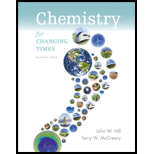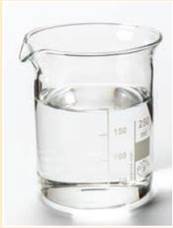
Chemistry For Changing Times (14th Edition)
14th Edition
ISBN: 9780321972026
Author: John W. Hill, Terry W. McCreary
Publisher: PEARSON
expand_more
expand_more
format_list_bulleted
Concept explainers
Textbook Question
Chapter 1, Problem 59P
(You may need data from Table 1.6 for some of these problems.)
59. A 40.mL quantity each of mercury and hexane, as well as 80 mL of water, is placed in the
250-mL beaker shown below. The three liquids do not mix with one another. Sketch the relative locations and levels of the three liquids in the container.

Expert Solution & Answer
Want to see the full answer?
Check out a sample textbook solution
Students have asked these similar questions
Describe the mesomeric or resonance effect and differentiate between types +E or +M and -R or -M.
I need help with the following two problems, understanding them in a simple manner. Can you please draw them out for me with a detailed explanation so that I can better comprehend? I'm a visual person, so I definitely need that. Thank you very much!
Problem 54, could you please explain it in detail? Thank you! Step by step, I'm really confused, so please don't make it overly complex. My question is to visually draw it out and demonstrate it to me; I'm confused about that problem, please (not just in words) but demonstrate it to me in all due essence (visually) with descriptions.
Chapter 1 Solutions
Chemistry For Changing Times (14th Edition)
Ch. 1 - Prob. 1RQCh. 1 - Why do experiments have to be done to support a...Ch. 1 - Why can't scientific methods always be used to...Ch. 1 - How does technology differ from science?Ch. 1 - Prob. 5RQCh. 1 - Prob. 6RQCh. 1 - What is a DQ? What does a large DQ mean? Why is it...Ch. 1 - What derived units of (a) mass and (b) length are...Ch. 1 - What is the Sl-derived unit for volume? What...Ch. 1 - Prefix Symbol Definition tera- T 1012 - M - centi-...
Ch. 1 - Prob. 11RQCh. 1 - Identify the following work as either applied...Ch. 1 - Penicillin kills bacteria, thus saving the lives...Ch. 1 - Prob. 14PCh. 1 - Prob. 15PCh. 1 - X-rays are widely used in medicine and dentistry....Ch. 1 - Prob. 17PCh. 1 - The virus called HIV causes AIDS, a devastating...Ch. 1 - Which are realistic masses for a cellular...Ch. 1 - In Europe, A2 sized paper measures 594 mm 420 mm,...Ch. 1 - Which one(s) of the following are likely to be...Ch. 1 - Sample X on the moon has exactly the same mass as...Ch. 1 - Which of the following is a reasonable volume for...Ch. 1 - Which of the following is a reasonable...Ch. 1 - Earth's oceans contain 3.501 0 8 mi3 of water and...Ch. 1 - What is the area of Earth's oceans in square...Ch. 1 - Consider the two tubes shown below. The aluminum...Ch. 1 - Which one(s) of the following could be the inside...Ch. 1 - Identify the following as physical or chemical...Ch. 1 - Identify the following as physical or chemical...Ch. 1 - Identify the following changes as physical or...Ch. 1 - Identify the following changes as physical or...Ch. 1 - Identify each of the following as a substance or a...Ch. 1 - Identify each of the following as a substance or a...Ch. 1 - Which of the following mixtures are homogeneous,...Ch. 1 - Which of the following mixtures are homogeneous,...Ch. 1 - Every sample of the sugar glucose (no matter where...Ch. 1 - An advertisement for shampoo says, "Pure shampoo,...Ch. 1 - Which of the following represent elements, and...Ch. 1 - Prob. 40PCh. 1 - Prob. 41PCh. 1 - Without consulting tables, write a symbol for each...Ch. 1 - In his 1739 textbook, Traite elementaire de...Ch. 1 - In 1774 Joseph Priestley isolated a gas that he...Ch. 1 - Change the unit for each of the following...Ch. 1 - Convert each of the following measurements to the...Ch. 1 - Carry out the following conversions. a. 5.52104 mL...Ch. 1 - Carry out the following conversions. a. 546 mm to...Ch. 1 - Indicate which is the larger unit in each pair. a....Ch. 1 - There are about...Ch. 1 - Express the length of a 31 -cm ruler in (a) mm,...Ch. 1 - What is the volume in liters of (a) a 352-mL soft...Ch. 1 - (You may need data from Table 1.6 for some of...Ch. 1 - (You may need data from Table 1.6 for some of...Ch. 1 - (You may need data from Table 1.6 for some of...Ch. 1 - (You may need data from Table 1.6 for some of...Ch. 1 - (You may need data from Table 1.6 for some of...Ch. 1 - (You may need data from Table 1.6 for some of...Ch. 1 - (You may need data from Table 1.6 for some of...Ch. 1 - (You may need data from Table 1.6 for some of...Ch. 1 - Prob. 61PCh. 1 - (You may need data from Table 1.6 for some of...Ch. 1 - (You may need data from Table 1.6 for some of...Ch. 1 - (You may need data from Table 1.6 for some of...Ch. 1 - Liquid nitrogen, used for freezing sperm samples,...Ch. 1 - Normal body temperature is about 37 °C. What is...Ch. 1 - Prob. 67PCh. 1 - Prob. 68PCh. 1 - A certain chemistry class is 1.00 microcentury ( ...Ch. 1 - 70. A unit of beauty, a helen, thought to have...Ch. 1 - 71. English chemist William Henry studied the...Ch. 1 - Prob. 72APCh. 1 - Prob. 73APCh. 1 - For Problems 74 and 75t, classify each of the...Ch. 1 - For Problems 74 and 75, classify each of the...Ch. 1 - Prob. 76APCh. 1 - Prob. 77APCh. 1 - Prob. 78APCh. 1 - Prob. 79APCh. 1 - Prob. 80APCh. 1 - Prob. 81APCh. 1 - Prob. 82APCh. 1 - Prob. 83APCh. 1 - Prob. 84APCh. 1 - Prob. 85APCh. 1 - Prob. 86APCh. 1 - The density of a planet can be approximated from...Ch. 1 - The extrasolar planet HAT-P-i orbits a star 450...Ch. 1 - Prob. 89APCh. 1 - Prob. 90APCh. 1 - Prob. 91APCh. 1 - Prob. 92APCh. 1 - Prob. 1.1CTECh. 1 - Prob. 1.2CTECh. 1 - Prob. 1.3CTECh. 1 - Prob. 1.4CTECh. 1 - Prob. 1.5CTECh. 1 - Prob. 1.6CTECh. 1 - Prob. 1CGPCh. 1 - Prob. 2CGPCh. 1 - Prob. 3CGPCh. 1 - Materials Needed: • 1/4 cup dark corn syrup • 1/4...Ch. 1 - Materials Needed: • 1/4 cup dark corn syrup • 1/4...Ch. 1 - Prob. 3CHQCh. 1 - Prob. 4CHQCh. 1 - Materials Needed: • 1/4 cup dark corn syrup • 1/4...
Knowledge Booster
Learn more about
Need a deep-dive on the concept behind this application? Look no further. Learn more about this topic, chemistry and related others by exploring similar questions and additional content below.Similar questions
- So, the first image is what I'm trying to understand regarding my approach. The second image illustrates my teacher's method, and the third image includes my notes on the concepts behind these types of problems.arrow_forwardHAND DRAWarrow_forwardDraw a mental model for calcium chloride mixed with sodium phosphatearrow_forward
- here is my question (problem number 20) please explain to me thanks!arrow_forwardThe bromination of anisole is an extremely fast reaction. Complete the resonance structures of the intermediate arenium cation for the reaction (Part 1), and then answer the question that follows (Part 2).arrow_forwardDrawing of 3-fluro-2methylphenolarrow_forward
arrow_back_ios
SEE MORE QUESTIONS
arrow_forward_ios
Recommended textbooks for you
 Chemistry: The Molecular ScienceChemistryISBN:9781285199047Author:John W. Moore, Conrad L. StanitskiPublisher:Cengage Learning
Chemistry: The Molecular ScienceChemistryISBN:9781285199047Author:John W. Moore, Conrad L. StanitskiPublisher:Cengage Learning Chemistry for Engineering StudentsChemistryISBN:9781337398909Author:Lawrence S. Brown, Tom HolmePublisher:Cengage Learning
Chemistry for Engineering StudentsChemistryISBN:9781337398909Author:Lawrence S. Brown, Tom HolmePublisher:Cengage Learning Chemistry: Principles and ReactionsChemistryISBN:9781305079373Author:William L. Masterton, Cecile N. HurleyPublisher:Cengage Learning
Chemistry: Principles and ReactionsChemistryISBN:9781305079373Author:William L. Masterton, Cecile N. HurleyPublisher:Cengage Learning
 Chemistry: Matter and ChangeChemistryISBN:9780078746376Author:Dinah Zike, Laurel Dingrando, Nicholas Hainen, Cheryl WistromPublisher:Glencoe/McGraw-Hill School Pub Co
Chemistry: Matter and ChangeChemistryISBN:9780078746376Author:Dinah Zike, Laurel Dingrando, Nicholas Hainen, Cheryl WistromPublisher:Glencoe/McGraw-Hill School Pub Co

Chemistry: The Molecular Science
Chemistry
ISBN:9781285199047
Author:John W. Moore, Conrad L. Stanitski
Publisher:Cengage Learning

Chemistry for Engineering Students
Chemistry
ISBN:9781337398909
Author:Lawrence S. Brown, Tom Holme
Publisher:Cengage Learning

Chemistry: Principles and Reactions
Chemistry
ISBN:9781305079373
Author:William L. Masterton, Cecile N. Hurley
Publisher:Cengage Learning



Chemistry: Matter and Change
Chemistry
ISBN:9780078746376
Author:Dinah Zike, Laurel Dingrando, Nicholas Hainen, Cheryl Wistrom
Publisher:Glencoe/McGraw-Hill School Pub Co
Measurement and Significant Figures; Author: Professor Dave Explains;https://www.youtube.com/watch?v=Gn97hpEkTiM;License: Standard YouTube License, CC-BY
Trigonometry: Radians & Degrees (Section 3.2); Author: Math TV with Professor V;https://www.youtube.com/watch?v=U5a9e1J_V1Y;License: Standard YouTube License, CC-BY